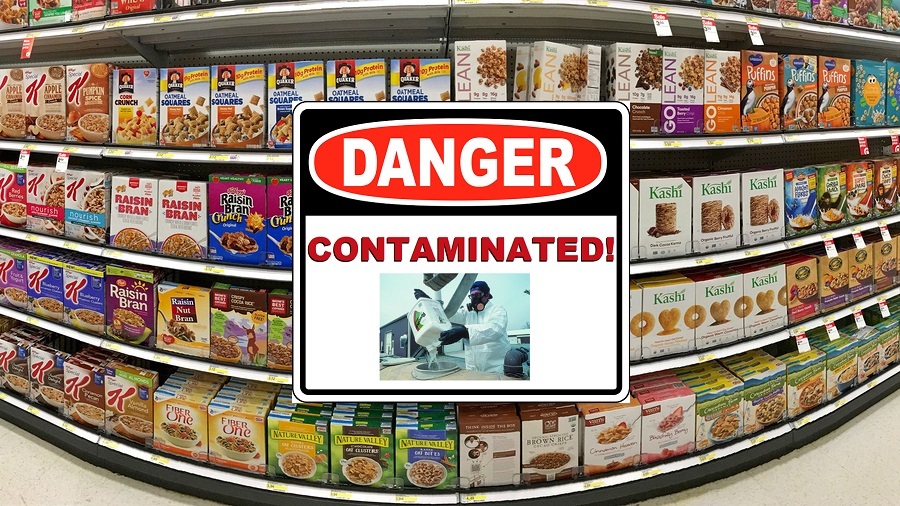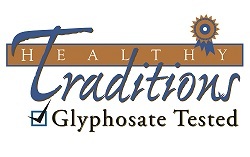
Comments by Brian Shilhavy
Editor, Health Impact News
If you have already had something to eat today prior to reading this article, chances are very high that you have already ingested glyphosate, the active ingredient in herbicides such as RoundUp, the most widely used agrochemical in the world.
Since I have earned my living for the past two decades by selling clean food, I have been warning the public now for many years about the dangers of these agrochemicals and the contamination of our nation’s commercial food supply.
If you do a search on “glyphosate” at Health Impact News, you will get search result list of over 380 articles that we have published during the past decade.
The advent of genetically modified (GMO) seeds in the late 1990s, particularly corn and soybeans, has allowed the agricultural chemical giants, such as Monsanto, to spray greater quantities of herbicides and pesticides onto the nation’s crops.
In 2014 we began testing commercial grain products to verify that North America’s wheat and grain supply was contaminated by the herbicide glyphosate, even though there are currently no GMO varieties of wheat or other grains.
We found it to be true, due to the practice of “desiccating” crops in the fall with glyphosate in the northern states and Canada to allow the farmers to harvest their wheat before the first snowfall.
Next, we tested our own USDA certified organic grains that we sold in our online store, and were shocked to find out that they were just as contaminated with glyphosate as non-organic grains. See:
ALERT: Certified Organic Food Grown in U.S. Found Contaminated with Glyphosate Herbicide
We immediately stopped selling our USDA organic grains, including corn, and began an intensive period of our company’s history in searching out clean sources of grains and corn that tested free of any glyphosate contamination. In fact, we now test ALL of the food we sell for the presence of glyphosate, and if a test turns out positive, we don’t sell it.

Click or tap here to learn more about our standards.
This has forced us to source much of our food from outside the U.S. We only know of a few wheat and grain farmers in the U.S. who consistently harvest grains that test free of glyphosate, and many of our grain products are actually imported from Italy where we have had greater success in finding small farms that protect against glyphosate contamination.
Corn produced the biggest challenge for us, and to this day we cannot find consistent clean sources of corn in North America, that not only test free of glyphosate, but also test free of GMO contamination, and that includes USDA certified organic corn.
For the past several years we have been sourcing and selling corn from central Mexico where GMO corn is banned.
This means that if you do any shopping at a grocery store chain, the most dangerous aisle, by far, is the aisle that contains cereals. I don’t even bother going down that aisle on the rare occasions where I visit a grocery store selling commodity food, as it is like choosing which kind of poison you want.
Outside of corn, oats are also among the most contaminated grains in America, with some testing done on American oat products showing 100% contamination.
We are probably one of the only places in the U.S. where one can purchase oats that have tested clean for the presence of glyphosate. We import them from Italy.
If you are new to this topic, I encourage you to read some of the articles we have published over the years on the glyphosate contamination issue, and the earlier works of scientists who were censored, such as Dr. Anthony Samsel and Dr. Stephanie Seneff.
Many people believe today that they are “gluten-insensitive” when in fact they are probably just allergic to glyphosate and other poisons in our grain supply.
Others go even further, especially those who follow the “paleo diet” philosophy, and wrongly conclude that grains were never meant to be consumed by humans.
And that is just false. Jesus himself referred to grains as an analogy of “life.”
Jesus said to them, “I am the bread of life. Whoever comes to me will not be hungry, and whoever believes in me will never be thirsty.” (John 6:35)
More on Glyphosate.
New US research finds “worrying” evidence linking Monsanto weedkiller to cancer
by Carey Gillam
The New Lede
New research by top US government scientists has found that people exposed to the widely used weed killing chemical glyphosate have biomarkers in their urine linked to the development of cancer and other diseases.
The study, published last week in the Journal of the National Cancer Institute, measured glyphosate levels in the urine of farmers and other study participants and determined that the presence of high levels of the pesticide were associated with signs of a reaction in the body called oxidative stress, a condition that causes damage to DNA. Oxidative stress is considered by health experts as a key characteristic of carcinogens.
The authors of the paper – 10 scientists with the National Institutes of Health and two from the Centers for Disease Control and Prevention (CDC) – concluded that their study “contributes to the weight of evidence supporting an association between glyphosate exposure and oxidative stress in humans.” They also noted that “accumulating evidence supports the role of oxidative stress in the pathogenesis of hematologic cancers,” such as lymphoma, myeloma and leukemia.
“Oxidative stress is not something you want to have,” said Linda Birnbaum, a toxicologist and former director of the National Institute for Environmental Health Sciences. “This study increases our understanding that glyphosate has the potential to cause cancer.”
The study findings come after the CDC reported last year that more than 80% of urine samples drawn from children and adults contained glyphosate. The CDC reported that out of 2,310 urine samples taken from a group of Americans intended to be representative of the US population, 1,885 were laced with detectable traces of glyphosate.
Glyphosate is the most heavily applied herbicide in history, both in the US and globally. One of the best-known glyphosate-based products is Monsanto’s Roundup weedkiller. Roundup has been used by farmers as well as consumers for more than 40 years. Officials with Monsanto and its German owner Bayer AG have always assured the public and regulators that exposure to the weed killer does not pose a threat to human health.
Bayer said the new NIH study has many “significant methodological limitations that affects its reliability,” and said the results conflict with other government research.
“The increased oxidative stress found in the study could have been caused by any number of non-glyphosate related factors or a combination of them, and the study does not support the conclusion that glyphosate is the cause,” Bayer said in a statement.
People are exposed to glyphosate by using products made with the chemical and also by eating food and drinking water contaminated with the pesticide. Scientists have found glyphosate residues in an array of popular foods and in waterways across the US.
Notably, in the new paper, the NIH and CDC scientists said that while their study focused on farmers who were exposed to glyphosate when they sprayed it on fields, they saw similar results in “non-farmers.”
The findings suggest “these effects may apply more broadly to the general population who are primarily exposed through ingestion of contaminated food and water or residential applications,” the study authors wrote.
The study is so significant that it warrants regulatory attention, said some independent scientists.
“This is a top level team of investigators and a highly credible study to which regulators need to pay attention,” said Phil Landrigan, a pediatrician and epidemiologist who worked for years at the CDC and the Environmental Protection Agency (EPA) and now directs the Program for Global Public Health and the Common Good at Boston College.
Michael Antoniou, a scientist with the department of medical and molecular genetics at King’s College in London who has been researching glyphosate for years, said the results were “worrying,” with “major health implications.”
Critical timing
The new government-funded study comes at a time when both the EPA and European regulators are completing updated assessments of glyphosate safety, and as health advocates are pushing for limits on use of the chemical or requirements that products such as Roundup be labeled with a cancer warning.
A European Food Safety Authority (EFSA) spokesperson said the agency was aware of the study and would consider whether or not the findings add “new evidence” as the agency completes its new glyphosate assessment. EFSA’s conclusions are due in July.
The EPA also said it was looking over the new study and would “carefully review” the findings as it finalizes its assessment.
“EPA takes very seriously our duty to protect human health and the environment,” the agency said in a statement.
The study also comes as Monsanto and Bayer remain mired in litigation brought by tens of thousands of cancer patients who claim exposure to Roundup caused them to develop non-Hodgkin lymphoma. The company has already agreed to pay out more than $11 billion to settle the bulk of the claims – without admitting any liability – but many cases have not settled and civil trials are continuing.
Bayer is also facing a surge in investor unrest and calls for a break-up and the ouster of top leaders after the company lost 40% of its market value following its 2018 acquisition of Monsanto.
Bayer maintains that glyphosate does not cause cancer and that products made with it can be used safety. The company states on its website that EPA and other regulatory reviews provide an “extensive body of research” that back the company’s safety pledge.
Though some countries have moved to ban glyphosate products, regulatory agencies in many countries say there is a lack of evidence connecting glyphosate herbicides to cancer, and that it is one of the safest and most effective herbicides available.
Last year, a risk assessment committee of the European Chemicals Agency (ECHA) concluded after reviewing multiple studies that there was no justification for classifying glyphosate as a carcinogen.
Many large US farm groups, including the American Farm Bureau Federation, American Soybean Association, National Corn Growers Association, National Association of Wheat Growers, National Cotton Council, and American Sugarbeet Growers Association, also say that glyphosate doesn’t cause cancer.
The EPA has said for years that it considers glyphosate as “not likely” to be carcinogenic, and in a 2020 updated review, the agency reiterated it saw no “human health risks of concern.” But the agency was forced to withdraw that safety determination last year after a federal appellate court invalidated the EPA’s assessment.
The court ruling said that the EPA did not properly follow scientific guidelines when it determined glyphosate was not carcinogenic, ignoring expert advice from scientific advisers and using “inconsistent reasoning.”
The EPA now is revisiting its glyphosate evaluation and expects to issue a decision for glyphosate in 2026.
Cancer not only concern
Debate over the safety of glyphosate has persisted for years and intensified after the International Agency for Research on Cancer (IARC), a unit of the World Health Organization, declared it “probably carcinogenic to humans” in 2015.
The new findings are not the first to look at glyphosate and oxidative stress. Animal studies and cellular studies have also found an association. But there are only a handful of such studies in humans.
The NIH study is the “largest investigation to date of the relationship between glyphosate exposure and oxidative stress markers,” said Jonathan Hofmann, an author of the study from the NIH’s National Cancer Institute.
Scientists say it is important to examine substances that may cause oxidative stress because a large body of scientific evidence suggests that long-term oxidative stress contributes to the development not only of cancer but also a range of chronic conditions, such as diabetes, heart disease, and reproductive problems, including male infertility.
One prior human study related to glyphosate and oxidative stress was published last year by a team of scientists specializing in public and environmental health at several US universities.
Those researchers analyzed 347 urine samples collected from pregnant women, finding that higher levels of oxidative stress biomarkers were seen in the samples containing concentrations of aminomethyl phosphonic acid (AMPA), a substance created when glyphosate breaks down in soil and water.
The authors of that paper noted that glyphosate and AMPA have been shown to disrupt hormone function and warned that more research was needed due to glyphosate’s “persistence within the environment, and potential for adverse effects during pregnancy.”
The new NIH study is considered part of the Agricultural Health Study (AHS), a long-term examination of the health impacts of pesticide use on farmers funded by the National Cancer Institute and the National Institute of Environmental Health Sciences in collaboration with the EPA.
Other AHS studies have provided sometimes conflicting findings on the question of whether or not glyphosate can cause cancer, but the scientists authoring the latest research said their study was distinctive for several reasons, including using urinary glyphosate exposure measurements and pesticide exposure histories for study subjects and including people who are not farmers.
The researchers said that though the associations between glyphosate and biomarkers of oxidative stress “mainly appear to reflect effects of recent occupational exposure, there was also some evidence of associations with longer-term exposure.”
Investigators at the NIH are exploring potential opportunities to follow up on these findings and address needs for future research, Hofmann said.
Lorette Picciano, executive director of the Rural Coalition alliance of farm workers, said she hopes the EPA will pay attention to the study.
“People are dying of these cancers,” she said. “This study is very important.”
Read the full article at The New Lede.
Comment on this article at HealthImpactNews.com.
This article was written by Human Superior Intelligence (HSI)
See Also:
Understand the Times We are Currently Living Through
The True Gospel of Jesus Christ Threatens the Business of the Freemasons and Technocrats
Who are God’s “Chosen People”?
KABBALAH: The Anti-Christ Religion of Satan that Controls the World Today
Christian Teaching on Sex and Marriage vs. The Actual Biblical Teaching
Exposing the Christian Zionism Cult
The Bewitching of America with the Evil Eye and the Mark of the Beast
Jesus Christ’s Opposition to the Jewish State: Lessons for Today
Identifying the Luciferian Globalists Implementing the New World Order – Who are the “Jews”?
The Brain Myth: Your Intellect and Thoughts Originate in Your Heart, Not Your Brain
What is the Condition of Your Heart? The Superiority of the Human Heart over the Human Brain
The Seal and Mark of God is Far More Important than the “Mark of the Beast” – Are You Prepared for What’s Coming?
The Satanic Roots to Modern Medicine – The Image of the Beast?
Medicine: Idolatry in the Twenty First Century – 10-Year-Old Article More Relevant Today than the Day it was Written
Having problems receiving our emails? See:
How to Beat Internet Censorship and Create Your Own Newsfeed
We Are Now on Telegram. Video channels at Bitchute, and Odysee.
If our website is seized and shut down, find us on Telegram, as well as Bitchute and Odysee for further instructions about where to find us.
If you use the TOR Onion browser, here are the links and corresponding URLs to use in the TOR browser to find us on the Dark Web: Health Impact News, Vaccine Impact, Medical Kidnap, Created4Health, CoconutOil.com.





















